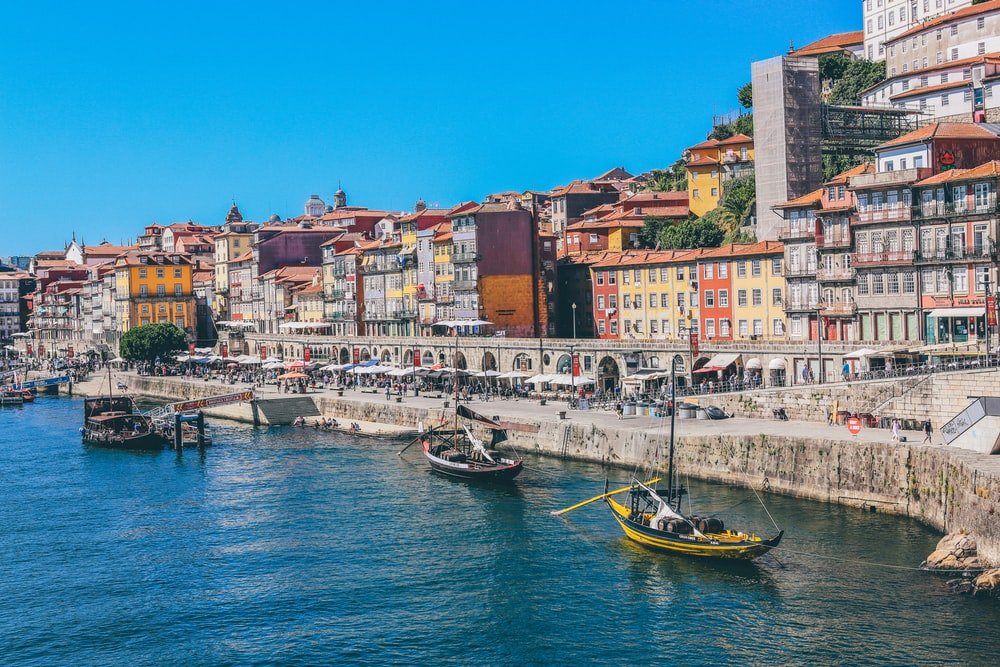
Portugal
Eucalyptus trees are very common in Portugal. The only other part of Europe where you’ll commonly see eucalyptus is northern Spain.
Concrete ladder poles, with very tall ladder steps, are common in Portugal. Each step often has a small see-through hole.
NOTE: In Spain and France you will commonly see ladder poles with short steps.
Hunting signs with a red and white colour scheme are a common sight in rural areas. They are either diamond shaped or rectangular.
NOTE: In contrast, Spanish hunting signs are white and black.
Portuguese bollards are either wedge-shaped with a noticeably thin white top, or flat with a wide reflector. While most reflectors will be white, you may also find orange reflectors. These are noticeably darker than the yellow reflectors in Spain.
Directional signs are generally white, with black arrows that are not touching the borders of the sign.
NOTE: Spanish directional signs will typically feature the road number in colourful boxes and do not have a black arrow, other than a thin black border.
Most kilometre markers are wide rectangles with a coloured section on the left side divided diagonally from the white part. Every kilometre you will find a larger square sign with a coloured top half featuring the road number.
Stop signs in Portugal feature a fairly large font.
NOTE: This is mostly useful to distinguish it from Spain, where stop signs have a distinctly small and compact font.
Pedestrian signs have five stripes, and the person is wearing a belt, which is noticeably high.
NOTE: Spanish pedestrian signs have eight stripes, Italian signs don't have a belt and Greek signs have two dotted lines instead of stripes.
Portugal uses A-type guardrails with red reflectors.
NOTE: This is mostly useful to tell apart Portugal and Spain, which uses yellow reflectors.
Portuguese road signs are typically encased by a white border.
NOTE: Most Spanish signs don’t have a white border.
The first three digits of Portuguese landlines make up the area codes, which are distributed as seen on the map. Phone codes not starting with a 2 are not regional, and codes starting with 29 will either be the Azores or Madeira.
For a complete list of the third digits, see this page.
Houses in northern Portugal are often made of square concrete blocks, which are commonly put together with white mortar.
NOTE: Very similar architecture, but typically without the white mortar, is commonly found over the border in Galicia.
Open fields sparsely populated with holm oaks (Quercus ilex) and cork oaks (Quercus suber) are very common in the southeast. These species of oaks tend to be on the smaller side, and have a Mediterranean look. While these fields will look quite dry during summer and fall, they will look much lusher during spring.
Olive plantations are generally more common in the eastern half of the country, particularly in the far northeast and slight southeast.
NOTE: The easiest way to tell apart the olive plantations from the oak fields from the last tip is to look at the pattern in which they’re planted. Olive plantations are typically planted in dense rows, while the oaks are planted more sparsely and not in an obvious pattern.
Forests, or plantations of Maritime pines (Pinus Pinaster) are very common in the northern half of Portugal. You can recognize the tree by its grey bark with red undertones, and fluffy branches that point upwards. Older trees often don’t have any branches in the bottom half of the tree.
NOTE: Plantations of this pine are also common in northern Spain, particularly Galicia.
In the Douro wine region, straight east of Porto, you will commonly find steep terraced vineyards.
In addition, here are some resources to help you practise Portugal:
Plonk It Portugal (map link) - This map contains locations for practising each meta in the Plonk It Portugal guide from step 2 to 3.




































